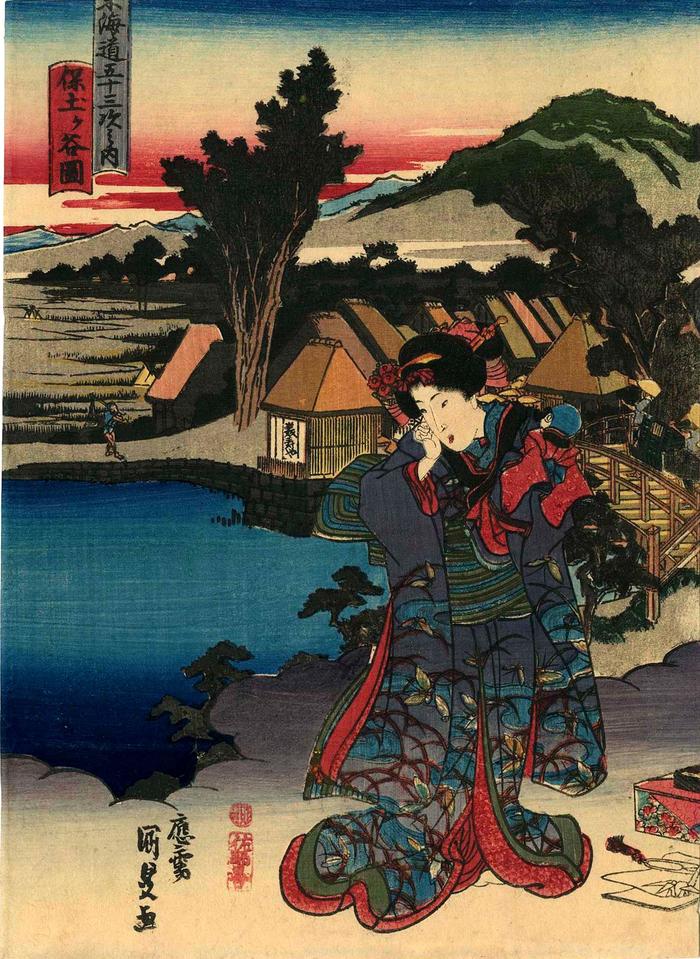Utagawa Kunisada (歌川国貞) / Toyokuni III (三代豊国) (artist 1786 – 01/12/1865)
View of Hodogaya (Hodogaya no zu: 保土ヶ谷図) from the series Fifty-three Stations of the Tōkaidō Road (Tōkaidō gojūsan tsugi no uchi: 東海道五十三次之内)
ca 1838
Signed: ōju Kōchōrō Kunisada (応需香蝶楼国貞)
Publisher: Sanoya Kihei
Censor's seal: kiwame
Museum of Fine Arts, Boston
National Diet Library
Museum für angewandte Kunst, Vienna
British Museum - Hiroshige's 'Hodaya Shimmachi-bashi' version
Ishikawa Prefectural Museum of Art - they date their copy to 1836
Bryn Mawr
Honolulu Museum of Art
The Spencer Museum of Art
Hokkaido Museum of Art
Muzeum Narodowe w Warszawie
Fujisawa Ukiyo-e Museum
Victoria and Albert Museum
Nelson-Atkins Museum of Art All of the prints in this series are chūban sized. The example of this print in the collection of the Museum of Fine Arts in Boston is 9 3/8 × 7 1/4 in. This one in the Lyon Collection is fractionally smaller because it has been trimmed slightly along the right hand side.
****
This is number five in the series. The curatorial files at the Museum für angewandte Kunst in Vienna say the young woman is holding a doll and not a child.
Hiroshige is believed to have made a summer journey to visit this village with its beautiful little bridge and its houses. There is a Hiroshige scene shown from a different angle and in a hortizontal presentation of this village seen in the snow, but he is never known to have gone there in the winter and therefore must be imaginary but based on an original summer time sketch.
In this Kunisada print there are three characters, the first two in kanji and the third in kana with the や character, written on the window of the structure at the water's edge, closest to the head of the bijin. While it would be tempting to think that it says "Hodogaya", I can't find any comparable written script that aligns with that theory. But it is interesting to note that the same structure with the same window appears in the Hiroshige prints, but in that case their is no writing on the window at all.
****
In Tokaido Landscapes: The Path from Hiroshige to Contemporary Artists, 2011, #5, p. 17, speaking of the original Hiroshige print it says in a text by Sasaki Moritoshi: "A Buddhist priest and a palanquin with porters are about to enter the station. Ahead, a throng of travelers can be seen among the buildings of the town. This succession of groups draws the eye to the course of the Tōkaidō and the extension of the journey. Fields open out on the left and the view extends to the mountains in the distance. Compared to the dense row of buildings on the right, this section functions as an open window and gives the landscape depth."
****
In Hiroshige: l'art du voyage, Paris, 2012, p. 56 it describes one small element of the Hiroshige print: "Le restaurant de l'autre côté du pont propose des nouilles, nihachi soba, à 16 mon." That is, there is a restaurant on the far side of the bridge that is advertising 'nihachi soba' noodles for the cost of 16 mon. This notation doesn't go any further in explaining the cultural undercurrents that every Japanese sophisticate would know. 'Nihachi soba' was a veiled reference to the erotic nature of young women.
Izzard noted this when he "quotes a poem by Funanoya Tsunando in which he plays upon the words nihachi [二八] and soba [そば]: "The controlling pun of the verse alludes to nihachi soba ('two-eight noodles'), noodles that cost sixteen mon a bowl. A common Japanese expression refers to a teenage girl of sixteen as nihachi, literally 'two eights'." Izzard points out that the pun has an extra punch by referring to a courtesan who claims to be sixteen, but in reality is somewhat older."
This source and quote comes via Printsofjapan.com and Kunisada's World, by Sebastian Izzard, Japan Society, Inc., 1993, cat. #20, p. 74.
In Hokusai and Hiroshige: Great Japanese Prints from the James A. Michener Collection, Honolulu Academy of Arts on page 166 it notes that nihachi "...is inexpensive - the same price for which the prints of Hokusai and Hiroshige were sold."
This significant element in the Hiroshige is not included in Kunisada's version. However, Kunisada does show a signboard on a building just over the bridge. As yet we have not translated it, but it does include the term 'ya' (や) or shop or establishment at the end. This may possibly be the signboard advertising a house of prostitution.
If you enlarge the image of the Hiroshige print which we have added to this page you will see that there is a woman inside of the soba noodle establishment with a couple of women outside. These do not appear in the Kunisada print, but may add to the significance of the term nihachi.
Hodogaya is a little more than three miles from Kanagawa and today is located within the city limits of Yokohama. The bridge is the Shinmachi Bridge (New Town Bridge) which links two parts of Hodogaya.
****
Illustrated in a small color reproduction in Kunisada's Tokaido: Riddles in Japanese Woodblock Prints by Andreas Marks, Hotei Publishing, 2013, page 63, T24-05.
Sanoya Kihei (佐野屋喜兵衛) (publisher)
boshi-e (母子絵) (genre)
landscape prints (fūkeiga 風景画) (genre)
beautiful woman picture (bijin-ga - 美人画) (genre)
